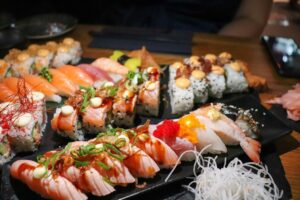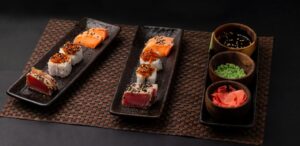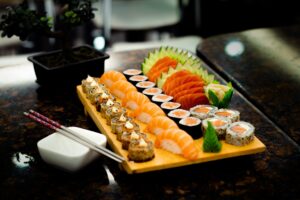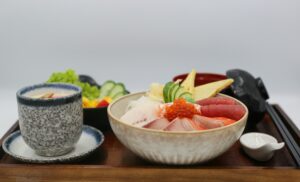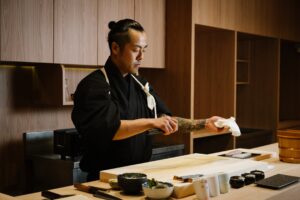
The Art of Sashimi: A Master Guide to Japan’s Finest Raw Fish Delicacy
In the world of Japanese cuisine, few dishes showcase the pure essence of fresh fish like sashimi. This revered culinary art form represents the pinnacle of simplicity and precision, where the quality of ingredients and the skill of preparation converge to create an unforgettable dining experience.
Unlike many dishes that rely on complex seasonings or elaborate cooking techniques, sashimi celebrates the natural flavors of premium ingredients in their purest form. This ultimate guide will take you through everything you need to know about sashimi, from its cultural significance to proper dining etiquette, helping you appreciate why this dish remains the ultimate test of a sushi restaurant’s expertise.
What is Sashimi: Understanding Japan’s Pure Expression of Fresh Fish
Sashimi is the art of serving thinly sliced raw fish or meat without the vinegared rice that defines sushi. The Japanese word “sashimi” literally translates to “pierced body” or “cut flesh,” with “sashi” meaning “pierced” and “mi” meaning “body” or “fish meat.” The term ‘mi’ specifically refers to the fish meat used in sashimi, highlighting the importance of the quality and texture of the fish meat in achieving the ideal sashimi experience. This etymology reflects the precise cutting technique that lies at the heart of sashimi preparation—each slice must be executed with surgical precision to achieve the perfect texture and presentation.
What sets sashimi apart from other raw fish preparations found around the world is its unwavering focus on purity. Sashimi is traditionally made with fish raw, which is a defining characteristic of the dish. While dishes like ceviche rely on acidic marinades or poke incorporates various seasonings, sashimi allows the fish’s natural flavor to shine through completely. This philosophy demands nothing less than the finest ingredients—what we call sashimi-grade fish—and the highest level of culinary skill.
At Sushi Masa by Ki-Setsu, our commitment to authentic Japanese traditions means understanding every nuance of this ancient craft—from selecting the freshest fish to mastering the delicate knife work that transforms raw seafood into edible art. Our head chef emphasizes that selecting fish for sashimi requires years of experience and a deep understanding of seasonal variations, texture, and flavor profiles. The process begins at dawn when our team inspects each delivery, examining the fish’s eyes for clarity, checking the firmness of the flesh, and ensuring the skin maintains its natural luster. Only fish that meets our stringent standards—often air flown from specific regions known for their superior quality—makes it to our sashimi selection.
The skill required to properly prepare sashimi-grade fish extends far beyond simple cutting. Each species demands different handling techniques, from the careful removal of bloodlines in tuna to the precise scoring required for certain white fish. This expertise, passed down through generations of Japanese chefs, transforms what might appear to be a simple preparation into a profound expression of culinary artistry.
Sashimi vs. Sushi: Key Differences Every Diner Should Know
The distinction between sashimi and sushi represents one of the most fundamental concepts in Japanese cuisine, yet it’s frequently misunderstood by diners unfamiliar with authentic Japanese cuisine. While both dishes may feature raw fish, their preparation, presentation, and dining experience differ significantly.
Sashimi is served without vinegared rice, allowing the fish’s natural flavor to be the sole focus of each bite. The absence of sushi rice means that every subtle nuance of the fish—its sweetness, umami depth, and textural qualities—can be fully appreciated without interference. This purity makes sashimi the preferred choice for showcasing the finest specimens, such as premium tuna belly or seasonal specialties that deserve undivided attention. Sushi restaurants often serve a variety of sashimi options, highlighting the freshness and quality of their seafood.

In contrast, sushi combines fish with carefully seasoned rice, creating a harmonious balance between the protein and the slightly acidic, sweet rice that complements and enhances the overall flavor profile. The process of making sushi involves preparing seafood, such as slicing fresh fish or squid, and assembling it with rice to create traditional sushi dishes. While sushi can include cooked ingredients, sashimi is always served raw, requiring the highest quality ingredients and meticulous handling to ensure safety and optimal taste.
As a leading omakase Singapore destination, Sushi Masa guides our guests in choosing between sashimi and sushi based on their preferences and the day’s selections. When we receive exceptionally fresh seasonal fish or premium cuts like otoro (fatty tuna belly), we often recommend experiencing them as sashimi first to fully appreciate their unique characteristics. The traditional presentation includes carefully arranged slices atop a bed of shredded daikon radish, accompanied by fresh wasabi, pickled ginger, and a small dish of premium soy sauce. To eat sashimi, diners typically dip each slice lightly in soy sauce, sometimes with a touch of wasabi, following traditional etiquette to enhance the flavors.
Understanding these differences enhances your dining experience and demonstrates respect for the centuries-old traditions that have shaped Japanese culinary culture. Each preparation method serves a specific purpose, and knowing when to choose sashimi over nigiri sushi can elevate your appreciation of this remarkable cuisine. A sushi restaurant is a typical place to enjoy both sushi and sashimi, offering an authentic atmosphere and a wide selection of expertly prepared dishes.
Premium Sashimi Varieties: From Ocean to Plate
Tuna Sashimi: The Crown Jewel of Raw Fish
Tuna sashimi represents the pinnacle of raw fish preparation, with different cuts offering distinct experiences that showcase the remarkable versatility of this prized fish. Alongside tuna, salmon sashimi is also a popular choice, celebrated for its tender texture and rich flavor. The three primary grades—maguro (lean tuna), chutoro (medium fatty tuna), and otoro (premium fatty belly)—each possess unique characteristics that require specific handling and cutting techniques to achieve perfection.
Maguro
Maguro, the deep red lean meat from the back and sides of the tuna, offers a clean, pure fish flavor with a firmer texture that provides satisfying resistance when bitten. This cut showcases the essence of what makes tuna so highly prized—its rich, oceanic taste without overwhelming richness. The meat should be sliced slightly thicker than other varieties, typically 8-10mm, to allow diners to fully appreciate its substantial texture. Slicing tuna sashimi in different thicknesses is important, as it impacts both the texture and the balance of flavor for each cut.
Chutoro
Chutoro, sourced from the belly area where lean and fatty meat intersect, presents a perfect balance of richness and clean fish flavor. The marbling of fat throughout the meat creates a luxurious mouthfeel while maintaining the bright, fresh taste that defines quality tuna. Chefs particularly value chutoro for its versatility—it appeals to both those seeking richness and those who prefer cleaner flavors. Compared to maguro, chutoro has a milder taste, while otoro is known for its strong flavor and creamy richness.
Otoro
Otoro, the most prized cut from the lower belly, melts on the tongue with an almost creamy taste that has earned it the nickname “tuna butter.” The extensive marbling creates an entirely different experience from leaner cuts, with the fat content providing richness that coats the palate. Due to its delicate nature, otoro requires the gentlest handling and is cut thinner than other tuna varieties to prevent the fat from overwhelming the palate.
Skipjack Tuna
Skipjack tuna is another traditional sashimi fish, valued for its distinctive flavor and seasonal availability in Japanese cuisine.
When preparing sashimi, it is essential to select a high-quality fish fillet, ensuring the freshness and safety required for raw consumption. Sashimi is always served raw inside, highlighting the freshness and quality of the fish, and is carefully sliced to enhance both presentation and taste.
At Sushi Masa, we source our tuna from specific regions known for their superior quality, often receiving fish that have been caught using traditional methods that minimize stress and preserve the meat’s integrity. Our sourcing relationships, built over many years, ensure we receive fish that meets our exacting standards for color, fat distribution, and flavor development.

Delicate White Fish and Seasonal Specialties
White fish varieties offer an entirely different sashimi experience, characterized by subtle flavors, delicate textures, and seasonal availability that makes each encounter special. Unlike the bold presence of tuna sashimi, white fish requires a more refined palate to appreciate the nuanced differences between species and the impact of seasonal variations on flavor and texture.
Tai (sea bream) stands as one of the most revered white fish in Japanese cuisine, prized for its sweet, clean flavor and firm yet tender texture. The best tai comes from cold waters during late autumn and winter when the fish develop a layer of fat that enhances both flavor and texture. The meat presents a beautiful translucent white color with a pearl-like luster that makes it as visually stunning as it is delicious.
Hirame (flounder) offers an even more delicate experience, with paper-thin flesh that requires exceptional knife skills to prepare properly. The fish’s mild flavor and almost silky texture make it an ideal introduction for those new to white fish sashimi. Hirame is traditionally cut using the usu-zukuri technique, creating tissue-thin slices that allow the fish’s subtle sweetness to emerge without overwhelming the palate.
When exploring sashimi options, it’s worth noting that farmed salmon is a popular choice due to its lower risk of parasite infection compared to wild salmon. Cured mackerel (shimesaba) is another traditional favorite, using preservation methods that enhance both safety and flavor. Mackerel sushi is a related dish that showcases the versatility of this fish in Japanese cuisine. For those seeking unique experiences, less common sashimi types such as chicken sashimi, horse meat, and raw beef are sometimes offered, each with their own cultural significance and safety considerations.
Other prized delicacies include sea urchin, known for its creamy texture and rich flavor, and salmon roe, which adds a burst of briny freshness. Squid is also featured in special preparations like ika somen, where it is cut into thin, noodle-like strips.
Different white fish varieties require specific cutting techniques to maximize their unique qualities. Firmer fish like tai benefit from slightly thicker cuts that allow diners to appreciate the meat’s natural resistance, while delicate varieties like flounder must be sliced paper-thin to prevent the texture from becoming chewy. Our chefs spend years learning to identify the optimal cutting approach for each species and individual fish.
Seasonal availability plays a crucial role in white fish selection, with many varieties reaching peak quality during specific times of the year. Spring brings young fish with tender flesh, while winter offers mature specimens with developed fat content that enhances flavor complexity. At Sushi Masa, we adjust our menu regularly to showcase fish at their seasonal peak, ensuring our guests experience each variety when it’s at its absolute best.
Proper handling and preparation are essential to minimize the risk of food poisoning and parasite infection, especially when serving raw or lightly cured seafood. Our commitment to safety ensures that every sashimi dish is both delicious and safe to enjoy.
Shellfish and Mollusks: Ocean Treasures in Raw Form
Shellfish and mollusks bring entirely different textures and flavors to the sashimi experience, ranging from the sweet, briny taste of fresh scallops to the firm, almost crunchy texture of a properly prepared sashimi piece of squid. These varieties require specialized preparation techniques and often benefit from live preparation to ensure optimal freshness and safety.
- Ika (squid) presents one of the most distinctive textures in sashimi, with its firm, almost chewy consistency that provides a satisfying contrast to the softer textures of fish. The key to an exceptional sashimi piece of squid lies in the preparation—the squid must be cleaned meticulously to remove the membrane that can create an unpleasant texture, and the meat is often scored in a crosshatch pattern to make it more tender while maintaining its characteristic bite. Each sashimi piece is carefully sliced and presented to highlight its unique texture.
- Tako (octopus) requires a completely different approach, as the meat must be tenderized before serving while preserving its unique texture. Traditional preparation involves briefly cooking the octopus in boiling water to achieve the proper texture—raw octopus would be too tough to enjoy. The result is a sashimi piece with a pleasantly chewy texture and sweet, oceanic flavor that pairs beautifully with a touch of wasabi.
- Amaebi (sweet shrimp) offers an entirely different experience, with delicate, almost creamy flesh and a natural sweetness that requires no enhancement beyond the traditional accompaniments. The shrimp are typically prepared live and served immediately, with each sashimi piece of translucent meat arranged to showcase its natural beauty. The contrast between the sweet meat and the subtle heat of wasabi creates a perfect flavor balance.
- Hotate (scallop) presents perhaps the most accessible shellfish option for sashimi newcomers, with its mild flavor and tender texture that appeals to a broad range of palates. The sweet, briny taste and firm yet yielding texture make each sashimi piece of scallop an excellent introduction to raw shellfish. At Sushi Masa, we source diver scallops that are opened immediately before serving to ensure maximum freshness and the clean, sweet flavor that defines quality scallops.
Our chef’s techniques for preparing live shellfish focus on timing and precision—each sashimi piece must be prepared as close to service as possible to maintain the delicate flavors and textures that make these varieties special. For garnish, we use thin strips of daikon, cucumber, or carrot, which are placed in ice water before serving to ensure they remain crisp and refreshing. The skill required to handle live shellfish safely while preserving their quality represents years of training and experience that we bring to every plate.
Master Cutting Techniques: The Foundation of Perfect Sashimi
The foundation of exceptional sashimi lies not just in ingredient quality, but in the master cutting techniques that have been refined over centuries of Japanese culinary tradition. Making sashimi requires mastery of specific cutting techniques, as each cut serves a specific purpose designed to enhance the natural characteristics of different fish types while creating the optimal texture and visual presentation that defines authentic sashimi.

Hira-Zukuri
Hira-zukuri, the rectangular cut, represents the most common and versatile technique used for most fish varieties. This method involves cutting straight down through the fish at a perpendicular angle to create uniform, rectangular pieces typically 7-10mm thick. The technique requires a smooth, confident motion with the yanagiba knife, allowing the blade’s sharpness to do the work rather than applying pressure that could damage the fish’s delicate cellular structure.
Usu-Zukuri
Usu-zukuri, the paper-thin cut, transforms delicate white fish into translucent slices that showcase both the chef’s skill and the fish’s inherent beauty. This technique requires exceptional knife control, as each slice must be cut at a precise angle to achieve uniform thickness without tearing the delicate flesh. The resulting pieces, often so thin they’re nearly transparent, allow the fish’s subtle flavors to emerge while creating an elegant visual presentation.
Kaku-Zukuri
Kaku-zukuri, the cube cut, offers a different approach that maximizes the fish’s natural texture through small, bite-sized pieces. This technique works particularly well with firmer fish varieties and allows diners to experience the full impact of the fish’s texture and flavor in concentrated form. The precise, uniform cubes demonstrate the chef’s control while providing an optimal eating experience.
The importance of blade angle and cutting motion cannot be overstated in sashimi preparation. As sashimi is a type of raw food, proper technique is essential not only for presentation but also for safety and maintaining the freshness of the ingredients. The knife must move through the fish in a single, smooth stroke, pulling the blade toward the chef while maintaining consistent pressure and angle. This technique, known as the “pull cut,” ensures clean edges that preserve the fish’s cellular structure and prevent the crushing that occurs with sawing motions.
Understanding grain direction represents another crucial element of master cutting techniques. Fish muscle fibers run in specific directions, and cutting against the grain—particularly important with firmer varieties—breaks down tough fibers while preserving the meat’s integrity. Our chefs at Sushi Masa spend years learning to read each fish’s grain structure and adjust their cutting approach accordingly.
At Sushi Masa, our knife skills training follows traditional Japanese methods, beginning with proper stance and grip before progressing to the precise hand movements that characterize master-level cutting. Each chef must demonstrate proficiency with multiple cutting techniques and understand how to adapt their approach based on the specific characteristics of individual fish specimens.

The Proper Way to Eat Sashimi: Etiquette and Enhancement
Experiencing sashimi properly involves more than simply eating raw fish—it requires understanding the traditional etiquette and enhancement techniques that maximize both flavor and respect for the culinary artistry involved. Sashimi is typically eat raw to preserve its natural taste, and diners eat each piece with care to fully appreciate its flavors. These time-honored practices, developed over centuries, ensure that each piece of sashimi is appreciated to its fullest potential.
Proper chopstick technique forms the foundation of sashimi appreciation. Unlike other foods that may be picked up with force, sashimi slices require gentle handling to preserve their delicate structure. The chopsticks should grasp each piece firmly but gently, allowing you to lift the fish without applying pressure that could damage its texture or cause it to fall apart.
The relationship between soy sauce and sashimi represents one of the most important aspects of proper enjoyment. Rather than drowning the fish in sauce, authentic sashimi appreciation involves using soy sauce sparingly to enhance rather than mask the fish’s natural flavors. The fish should be lightly dipped in soy sauce, typically touching only one edge or corner, allowing the sauce to provide a subtle umami enhancement without overwhelming the delicate taste.
Wasabi usage requires similar restraint and understanding. Rather than mixing wasabi directly into soy sauce, traditional etiquette calls for placing a small amount of freshly grated wasabi directly onto the fish or eating it alongside each piece. The heat and flavor of authentic wasabi—not the common horseradish substitute—provides a clean, sharp sensation that cleanses the palate and enhances the fish’s natural flavors.
Grated ginger serves as a palate cleanser between different types of sashimi, particularly when transitioning from lighter to richer varieties or between different species. A small piece of ginger eaten between different fish helps reset your taste buds and allows you to fully appreciate the unique characteristics of each variety.
The role of traditional accompaniments extends beyond flavor enhancement to include visual and textural elements that complete the sashimi experience. Daikon radish, typically shredded into fine julienne, serves both as a bed for presenting the fish and as a palate cleanser with its mild, slightly peppery flavor and crisp texture. Shiso leaves provide an aromatic herb note that complements certain fish varieties while adding visual appeal to the presentation.
At Sushi Masa, our sake pairings are carefully selected to complement different sashimi varieties without overwhelming their delicate flavors. Light, clean sake works beautifully with white fish, allowing their subtle characteristics to shine, while richer varieties can stand up to the bold flavors of premium tuna. Our sake sommelier works closely with our sushi chefs to recommend pairings that enhance the overall dining experience.
Quality and Safety: What Makes Sashimi-Grade Fish Special
The designation “sashimi-grade” represents far more than a marketing term—it encompasses a comprehensive system of standards, handling protocols, and safety measures that distinguish fish suitable for raw consumption from ordinary seafood. Understanding these stringent requirements helps appreciate why authentic sashimi commands premium prices and why sourcing relationships are so crucial to restaurants like Sushi Masa.
Sashimi-grade fish must meet exceptional standards that begin with the fishing process itself. Traditional methods like ikejime, which involves quickly killing the fish with a spike to the brain, minimize stress-induced lactic acid buildup that can affect both flavor and texture. This technique, followed by immediate icing in a slurry, can preserve fish quality for up to ten days without deterioration—a remarkable achievement that distinguishes premium suppliers from commercial operations.
Proper handling and storage maintain the cold chain from boat to restaurant, with temperatures carefully controlled to prevent bacterial growth and preserve texture and flavor. Any break in this chain can compromise safety and quality, increasing the risk of food poisoning. Reliable supplier relationships are essential for authentic sashimi preparation.
The importance of parasite prevention through proper freezing techniques is crucial for sashimi safety. Freezing fish at regulated temperatures—such as -4°F for seven days or -31°F for 15 hours—eliminates parasites like those causing anisakiasis and diphyllobothriasis. Although “fresh never frozen” is often preferred, controlled freezing ensures safety without compromising flavor or texture, reducing the risk of parasite infection from raw sashimi consumption.
At Sushi Masa, our daily fish inspection process begins each morning with our head chef personally examining every delivery. The evaluation includes checking the fish’s eyes for clarity and fullness, examining the gills for bright red color, and testing the flesh for proper firmness and spring-back when pressed. The skin should maintain its natural luster and slippery feel, while any off-odors immediately disqualify a specimen regardless of its pedigree.
Quality indicators extend beyond visual inspection to include understanding seasonal considerations that affect fish condition. Many species reach peak quality during specific seasons when their fat content and flavor development are optimal. Our sourcing decisions take these natural cycles into account, ensuring we offer each variety when it’s at its absolute best rather than simply when it’s available.
Experience Authentic Sashimi at Sushi Masa
At Sushi Masa, our commitment to authentic sashimi preparation goes beyond technique—it honors centuries-old traditions that make this art form exceptional. As a hidden gem for sashimi lovers, we offer an exclusive dining experience focused on exceptional quality and traditional elegance. From sourcing the finest ingredients to presenting them perfectly, we strive for nothing less than perfection.
We build strong relationships with suppliers who share our dedication to quality, including fishermen using traditional methods and distributors handling sashimi-grade fish with care.

We encourage our guests to ask about our daily fresh fish selections and the specific preparation methods we recommend for each variety.
Whether you’re new to sashimi or consider yourself a connoisseur, visiting https://kisetsu.com.sg/ offers an opportunity to experience this remarkable cuisine as it was meant to be enjoyed. Our commitment to authenticity, quality, and traditional preparation ensures that each visit provides not just a meal, but a connection to the rich culinary heritage that makes Japanese cuisine so extraordinary.

